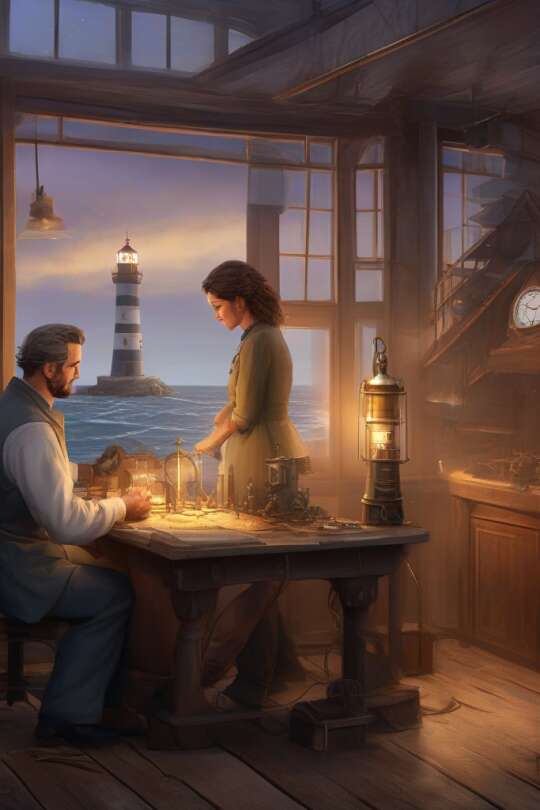
The Lightkeeper's Clock
About the Story
A coastal romance about Lila, a watchmaker-restorer, and Elias, a lighthouse keeper, who join forces to save their harbor from redevelopment. A story of small machines, patient courage, and the delicate work of keeping community and love alive.
Chapters
Related Stories
Lanterns at Low Tide
A marine acoustic engineer and a lighthouse keeper find more than data while saving their harbor from development. Through an elderly keeper's artifacts, old letters, and a peculiar signal from the bay, science and memory weave a tender romance that anchors a town.
Clay and Constellations
A ceramic artist returns to a mountain village and meets a visiting astrophysicist; together they fight to save a decaying observatory. Between wet clay and starlight, their slow-burn bond faces storms, sabotage, and the pull of difficult pasts, until a night of lanterns changes everything.
We Belong Here
In a sunlit coastal city, a young ocean acoustics researcher moves onto Rua Azul and hears a violin from a small workshop. As developers threaten the block’s community hall, she and the luthier fight to save it. With a mentor’s gift and a city’s heartbeat, they face legal hurdles, storms, and fear—finding courage, home, and love.
Rooftop Honey, City Heart
A young architect with insomnia and a rooftop beekeeper join forces to save their building’s hives from a pesticide deadline. With the help of a wise neighbor, storms, paperwork, and a city inspector, they craft safety, community, and a slow-blooming love under Brooklyn’s golden hum.
Thread and Sea-Glass
In coastal Gdańsk, a bookbinder finds a salt-stiff journal brought by a visiting glass artist. Hidden letters and a brass key lead them to a lighthouse, an elderly witness, and a lost love. Amid archives, kilns, and the river’s breath, they face a claim on the past and choose a future together.
Ratings
Reviews 5
Okay, I have to confess: I went in expecting quaint coastal fluff and instead got properly invested. The book’s sense of rhythm — the sea, the town, the tiny heartbeats of gears — is intoxicating. The lines about Lila’s laugh being “a bell quickly struck” and her hands remembering every gear are little punches of character that keep landing. The redevelopment subplot could've been another cardboard villain, but the communal consultations and the way folks show up for a harbor they love adds a welcome civic flavor. Elias as a lighthouse keeper? Classic, yes. But he’s not just a Broody Lighthouse Man™; his quiet courage and the scenes where he and Lila patch up both machines and trust felt very earned. A few predictable notes here and there, but honestly I was rooting for them the whole way. Charming, observant, and occasionally sneaky in its emotional hits. Worth your time if you like books that care about the small things.
A short, lovely read. I adored the rhythm of Greyhaven — mornings that refuse to hurry, the attic full of ticking, Lila's flour-streaked apron — and the way small objects carry history (hello, brass seagull). The envelope-under-the-door scene made my stomach flip; that quiet dread is handled so well. Sweet, grounded, and honest. 😊
I read The Lightkeeper's Clock in one late-morning sitting and felt like I'd been handed a warm cup of tea. Lila's workshop — shutters half-open, the tiny tick of escapements, the brass seagull waiting on the table — is sketched so lovingly that I could practically smell the grease and sea salt. The scene where the stamped envelope slides under her door and the attic swims with dread is one of those small, perfect moments that set the stakes without shouting. Elias feels like a character you want to know more about from the moment he appears at the harbor light; their cautious, patient courtship mirrors Lila's slow, methodical restoration work in a way that made my chest ache a little. The book balances community stakes (the redevelopment notice hits home hard) with intimate details — flour in the cracks of an apron, the rasp of a file — and it all rings true. Cozy, tender, and quietly brave. I wanted more pages when it ended.
I wanted to love this more than I did. The setting—Greyhaven, the attic workshop, the mechanical seagull—was evocative and beautifully described, and the author clearly has a flair for sensory detail. But for me the plot moved too gently for too long: the redevelopment notice is a strong inciting incident, yet the response feels undercooked. Lila and Elias decide to join forces quickly, and several scenes that should have tested their convictions or the community’s resolve are skimmed over. Elias himself remains a bit of a cipher compared to Lila; I never felt I fully knew his stakes beyond the lighthouse as a romantic symbol. There are also moments where the prose leans toward cutesy metaphors that pulled me out (e.g., too many times equating gears to personal traits). In short: lovely imagery and a cozy mood, but predictable beats and pacing issues kept this from fully landing for me.
This is the sort of small-town romance that rewards attention. The prose is economical but full of texture: the ropes creaking “like old throats,” windows fogging from kettles, and the recurring motif of tiny machines that need patient hands. Lila is well-drawn — thirty and stubborn, a watchmaker who both literally and metaphorically mends things — and the mechanical seagull on her bench is a beautifully chosen emblem for the novel’s themes of rescue and memory. The redevelopment notice is handled deftly; it becomes a community problem rather than a private melodrama, which grounds the plot. If I have a quibble, it's that Elias' interior life could be probed a touch deeper (his anchor-in-the-lighthouse role is evocative but sometimes feels a beat behind Lila's vividness). Still, the author nails atmosphere and pacing for the most part, and the ending's hopeful tone suits the book. Recommended for readers who like character-driven romances with a strong sense of place.

